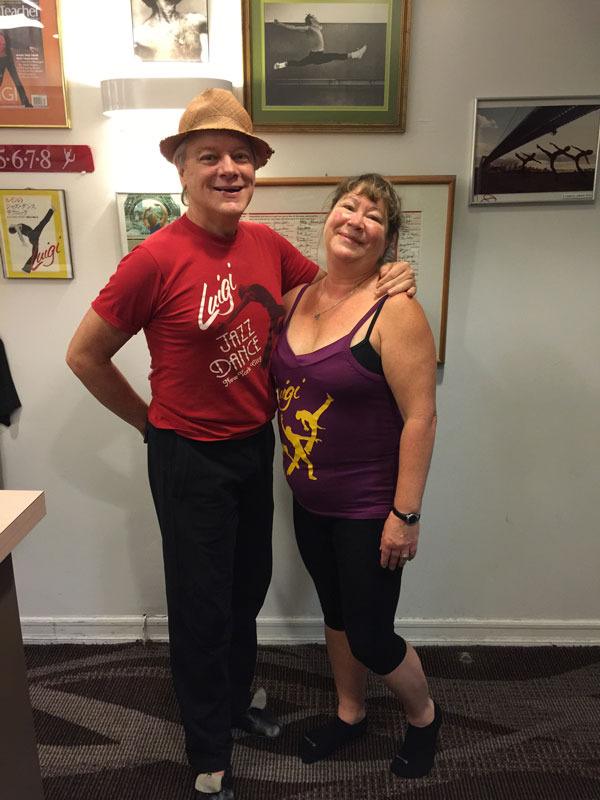From New York City to Tokyo, Eugene Louis “Luigi” Faccuito’s jazz exercise technique has left a lasting mark on the dancing world — and at the end of the month, his chief prodigy will give South Whidbey the chance to learn his famed mentor’s authentic techniques.
Manhattan-based jazz dance teacher Francis Roach is jetting over to South Whidbey from the Big Apple as part of his quest to teach dancers around the globe Faccuito’s techniques. This is Roach’s first time instructing in the Puget Sound area and, according to organizer and Sojourn Studios dance instructor Daunne Zinger, it’s a rare opportunity to learn from one of the best instructors in the Broadway scene. Faccuito himself led dance workshops in Seattle decades ago when he was alive and healthy. He died in April 2015 at 90 years old, and Roach has since become the chief instructor of his technique.
Roach is running dance classes on the South End at 6 p.m. on Friday, Aug. 26 at Whidbey Flex Studio, as well as 11 a.m. and 1 p.m. on Saturday, Aug. 27 at Island Dance and Gymnastics. Zinger has also organized a session at Spectrum Dance in Seattle at 10 a.m. on Sunday, Aug. 28. Tickets cost $25 per class, and space is available in all sessions. Pre-registration is required.

Since Faccuito’s death, Roach has taken the reins at Luigi’s Jazz Center in New York City. Roach cared for Faccuito in his later years, and taught lessons when Faccuito’s health began to deteriorate. The center welcomes dancers of all abilities, but takes in regular visitors from show business who are looking to prepare for performances and dances. Performers such as Liza Minelli, Barbra Streisand and John Travolta have been to Luigi’s Jazz Center classes and were a few of Faccuito’s favorites, Zinger said. His influence is widely acknowledged, and he is recognized as a pioneer in the dance world.
“Not only was Luigi a big player, he is known as the father of jazz dance,” Zinger said. “He developed his own dance technique back in the ’40s and ’50s and it became the Broadway jazz style that is prevalent even today. He has many arms and his influence was far reaching.”
Roach has been under Faccuito’s wing for nearly 40 years, and has taken his place as the preeminent jazz dance teacher in New York City, Zinger said. While being a dance form in itself, many performers take the lessons to strengthen their bodies for future performances. Many of Faccuito’s techniques are exercises that build core and joint strength, and it was with that intention that the style was invented in the first place.
Faccuito’s performing career nearly came to an end in his early 20s when he nearly died in a car wreck and fell into a coma. Upon awakening, doctors told him he most likely wouldn’t walk ever again, let alone dance. Out of necessity, he created a technique with various movements and exercises to work certain muscles and ligaments to whip his body into shape and someday get his dancing shoes back. He set out with the intention to “never stop moving,” and those words became the signature of his jazz dance technique.
Zinger says the exercises are primarily core based, similar to pilates. Many of the techniques protect knees, stretch and strengthen shoulders and chest and improve footwork speed. The moves are designed to ease pain on the body, and are seen as healthy for the elderly crowd.
“Movement is so primary, if we don’t move, we start aching,” Roach said. “Sometimes you have to work through aching and go through a little bit of discomfort to get comfortable again.”

Those words ring true for Zinger. When she herniated two discs in her spine in 2010, she was wheelchair bound and told by doctors she would likely never dance again. Yet she followed the path set by Faccuito and never stopped moving, working her body as much as she could from her wheelchair. Slowly but surely, she worked her way out of the wheelchair, onto her feet and into the studio. Now Zinger is preaching the same mindset to her dance students at Sojourn Studios, and she’s hooked many of her students, including 74-year-old Langley resident Carol Bingman.
“I lost weight and I feel like the dances made me stronger and kept me healthier,” Bingman said. “For a non-dancer, I never felt threatened or intimidated and it never hurts my body.”
According to both Roach and Zinger, Faccuito’s technique is for dancers of all abilities, even the inexperienced. It’s not about impossible moves that only the supremely talented can pull off, they say, but rather very doable moves that are deceivingly difficult to perfect. It’s an aspect of the technique that derives from the story, from Faccuito’s background overcoming the odds when all doubted him. It’s inspired others to overcome their own odds — others like Zinger.
“The whole rehabilitation aspect of his exercises resonated with me very personally in 2010,” Zinger says. “Now my students enjoy how the moves don’t hurt their bodies and strengthens them, even as they age.”

